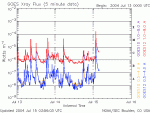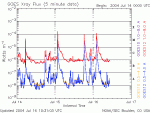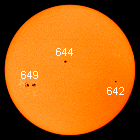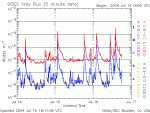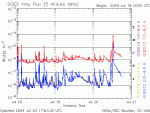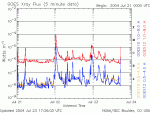Finally found that article about the 1859 solar storm. Fair Use.
http://www.space.com/scienceastronomy/mystery_monday_031027.html
The Great Storm: Solar Tempest of 1859 Revealed
By Robert Roy Britt
Senior Science Writer
posted: 06:00 am ET
27 October 2003
A pair of strong solar storms that hit Earth late last week were squalls compared to the torrent of electrons that rained down in the "perfect space storm" of 1859. And sooner or later, experts warn, the Sun will again conspire again send earthlings a truly destructive bout of space weather.
If it happens anytime soon, we won't know exactly what to expect until it's over, and by then some modern communication systems could be like beachfront houses after a hurricane.
In early September in 1859, telegraph wires suddenly shorted out in the United States and Europe, igniting widespread fires. Colorful aurora, normally visible only in polar regions, were seen as far south as Rome and Hawaii.
The event 144 years ago was three times more powerful than the strongest space storm in modern memory, one that cut power to an entire Canadian province in 1989. A new account of the 1859 event, from research led by Bruce Tsurutani of NASA's Jet Propulsion Laboratory, details the most powerful onslaught of solar energy in recorded history.
Solar conspiracy
Space storms are created when the Sun erupts, sending charged particles racing outward, an expanding bubble of hot gas called plasma.
In 1859, four crucial events conspired at one moment, Tsurutani told SPACE.com.
"The plasma blob that was ejected from the Sun hit the Earth," he said. That's a relatively routine event. What preceded the strike was more unusual. "The blob came at exceptionally high speeds. It took only 17 hours and 40 minutes to go from the Sun to Earth." Solar storms typically take two to four days to traverse the 93 million miles (150 million kilometers).
"The magnetic fields in the blob, called a coronal mass ejection, were exceptionally intense," Tsurutani said. "And the fourth, most important, ingredient was that the magnetic fields of the blob were opposite in direction from the Earth's fields."
Earth's magnetic field normally protects the surface of the planet from a continual flow of charged particles, called the solar wind, and even does a pretty good job defending against some storms. When a storm swept past Earth last Friday, it met up with magnetic field pointed in such a way that it thwarted the storm's effects. That's not always the case.
In 1859, the planet's defenses were overwhelmed.
That was then …
Society back then did not notice the storm the way it would today. The telegraph was 15 years old. There were no satellite TV feeds, no automated teller machines relying on orbiting relay stations, and no power grids.
Tsurutani said scientists can't yet accurately measure or predict what the strength or direction of Earth's magnetic field will be when a storm arrives. The storms themselves can be predicted. And Tsurutani says there will eventually be another one like 1859.
"It could very well be even more intense than what transpired in 1859," he says. "As for when, we simply do not know."
Bernhard Fleck, the European Space Agency's project scientist for the Sun-watching SOHO spacecraft, says the next super space storm will be detectable, but that's only half the story.
"A monster event of the magnitude described [by Tsurutani] we would easily recognize as something extraordinary with SOHO and other solar instruments," Fleck said in an e-mail interview. But, he added, "We certainly wouldn't know its full extent until arrival."
During the 1859 flare-up, solar observers logged almost an entire minute during which the amount of sunlight doubled at the region of the flare.
"Such a strong white-light flare has never been seen since," says Paal Brekke, SOHO deputy project scientist. "So if this type of flare happened, yes we would know right away." But he adds that the orientation of Earth's magnetic field would not be known. Future space-based observatories could address this blind spot in space weather forecasting.
Meanwhile, the blind spot became clear on Friday.
Forecasters at NOAA's Space Environment Center, relying on SOHO pictures and data, warned of an impending set of storms that could disrupt communications and might set off colorful aurora Friday and Saturday. The forecast, along with two Jupiter-sized sunspots at the roots of the storms, gained widespread media attention.
But the first and larger of the storms passed by with far less effect than one might have been led to expect. In fact, they were both comparative drops in the space weather bucket.
Extreme measures
To get an idea of the strength of the 1859 storm, you have to wade into nT's for a moment.
A space storm's impact is measured in nano-Teslas (nT), Brekke explained. The lower the figure, the more powerful the storm. A moderate storm can be around -100 nT; extreme and damaging storms have been logged at around -300 nT.
The 1989 coronal mass ejection that knocked out power to all of Quebec, Canada measured -589 nT, Brekke said. The 1859 perfect storm was estimated to have been -1,760 nT. Brekke used three exclamation points in his e-mail delivering that number.
People on the ground are generally safe even in the worst space weather. But technology could be in trouble when the next super storm hits.
"In 1859, the technology was quite low in comparison to today's technology," Tsurutani said. "However the technology that we rely on today is much more vulnerable."
A strong storm does its damage in part by inducing currents on power and communication lines, leading to potential overloads. Obviously, there are a lot more wires on Earth today, "so one might expect much worse problems if it occurred today."
The charged particles can also zap satellites, as has occurred with handful of storms in recent years -- events with far fewer charged particles than in 1859. A space storm also heats the upper level of Earth's atmosphere, causing it to expand. That's no good for satellites that can get caught up in air that didn't used to be there.
"This can lead to enhanced satellite drag and possible loss of these to the atmosphere," Tsurutani said.
Tsurutani and his colleagues -- Walter Gonzalez of the Brazilian National Space Institute and Gurbax Lakhina and Sobhana Alex of the India Institute of Geomagnetism -- reviewed known observations of the 1859 event's solar and aurora output, plus accounts from the ground. They also used recently rediscovered historic data on Earth's magnetic field from the Colaba Observatory in India.
The findings were published in a recent issue of the Journal of Geophysical Research.
This article is part of SPACE.com's weekly Mystery Monday series.
Mysteries of the Sun
Mystery Monday Archives



